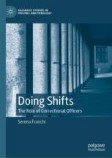Search
Search Results
-
If the face fits: predicting future promotions from police cadets’ facial traits
ObjectiveTo evaluate the relationship between police cadets’ facial traits and their subsequent promotional success.
MethodsUsing archival police...

-
Callous-Unemotional Traits and Empathy
People with callous-unemotional (CU) traits have been shown to lack empathy. But is this accurate across contexts? Through exploring empathy...
-
Does constructing a facial composite affect eyewitness memory? A research synthesis and meta-analysis
ObjectivesWe conducted a meta-analysis to assess whether the construction of facial composites affects witnesses’ lineup identification decisions.
...
-
The Nonverbal Behavior and Appearance of Police Officers in the Police Service
In police operations, nonverbal communication, including police officers’ appearance, is omnipresent and manifold. Indeed, nonverbal behavior...
-
Intra and Extra-Familial Child Sexual Abuse: The Role of Psychopathy
The present study analyses the relationship between psychopathic traits, the four facets of psychopathy (i.e., interpersonal, affective, lifestyle,...
-
Narcissistic Personality Disorder and Deviant Behavior
Pathological narcissism and narcissistic personality disorder (NPD) are factors in numerous deviant behaviors, including white collar crime, domestic...
-
Biology and Criminology: Data Practices and the Creation of Anatomic and Genomic Body ‘Types’
The use of biometrics for the creation of visual ‘body types’ needs continued criminological engagement. This article discusses Lombroso’s practice...
-
The Interview: A Basic Tool Used in Correctional Counseling and Treatment
The interview is the basic tool used by criminal justice agencies to obtain information from offenders and witnesses. It is also used to gather...
-
How to Investigate a Criminal Psychopath?
Psychopathy is one of the most destructive psychiatric disorders found in any society, not only for the severity and violence of the behaviors it...
-
Psychology: The Science of Mental Processes
The complexity of human behaviour has intrigued mankind because of its conscious and subconscious motivations. Psychologists try to find the causes...
-
Would you let this guy into a bar? Identifying cues that signal a perceived increase in the propensity for violence of potential bar patrons
ObjectivesBars, pubs, and clubs are hotspots for alcohol-related aggression. Consequently, admittance decisions made by security personnel have...

-

-
Dinosaurs, Hot Summers, the James Webb Telescope and the Criminological Imagination: An Introduction
This first chapter serves as an introduction to the main topics and imaginative starting point of the book, which is the criminological imagination...
-
Pervasive Social Control: How Merit Shapes Authorities’ Perception
This chapter documents the use of discretion by those in charge of enforcing rules and implementing programs, using the moral category of...
-
Masculinities, Punishment and Power
This chapter explores the literature on masculinities, punishment, and power. It considers the evolution of critical masculinities research, from the...
-
To Be or Not to Be Empathic: the Role of Empathy in Child Sexual Offending
Although treatment providers very often use empathy training in treatment for those who sexually offend, it is essential to further investigate the...
-
Antisocial Personality Disorder
Antisocial personality disorder (ASPD) is a debilitating condition that continues to be under-diagnosed and untreated.
-
Transcranial magnetic stimulation over the dorsolateral prefrontal cortex affects emotional processing: accounting for individual differences in antisocial behavior
ObjectivesThe study was designed to investigate the effects of transcranial magnetic stimulation (TMS) over the dorsolateral prefrontal cortex...

-
Artificial Intelligence, Algorithmic Governance, and the Manufacturing of Suspicion and Risk
We turn to the ways in which securitized and criminalized compliance is being built into the hostile algorithmic architectures that increasingly seek...
-
Understanding Animal Maltreatment
Chapter 3 explores the psychological sequelae of animal maltreatment, including risk factors of and correlates...
